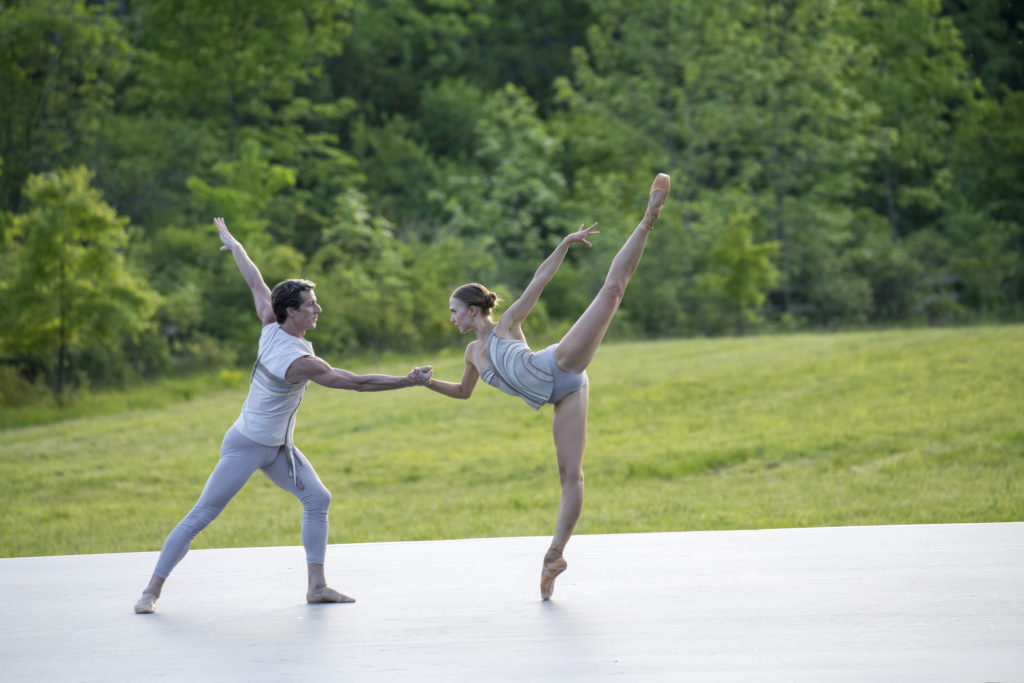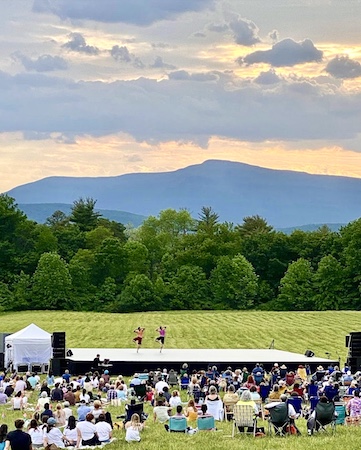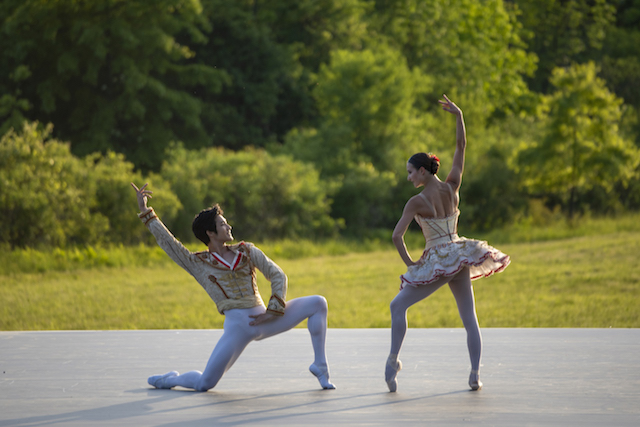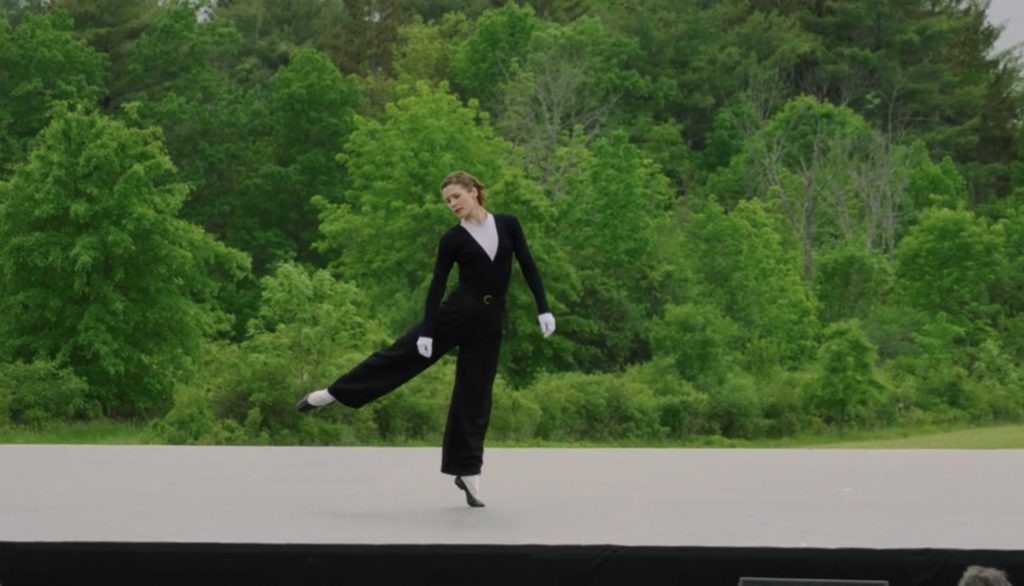
“Ooh that feels so good!” The speaker was not involved in a semi-pornographic film. She was a teenager watching a filmed pas de deux at a summer dance festival years ago. Others shushed her; this was art! Indoctrinated, did they even notice that the male dancer, hoisting his partner overhead, had placed one hand on her crotch?
Please be forbearing when I tell you that this memory edged into my consciousness just as I was sitting down to write about the Spring Festival program that took place place at Kaatsbaan Cultural Park in Tivoli, New York on Saturday, May 22, 2021. Nor was I among those sitting on the grass or testing mics. No, I was sitting at my laptop waiting for the countdown.
The reason for the above declamations? Located in western Massachusetts, watching a series of duets and a solo on a small screen, I am becoming increasingly aware of the differences between them and the live performance they capture. Also, due to weather and distances, the reception was often, well, difficult. One second, a dancer would jump and then…she’d be caught about to turn.
Here’s the program. it’s your choice choreographed by Michelle Dorrance in collaboration with the performers; Mark Morris’s Three Preludesand his Words;A Time There Was by Gemma Bond; and the Act III pas de deux from Don Quixotechoreographed by Marius Petipa and Alexander Gorsky that dates back to the turn of the 19thcentury. It’s no wonder I start thinking about gendered behavior, as well as welcoming the blurring of racial differences.

In Dorrance’s work, composers Aaron Marcellus and Penelope Wendtlandt appear alongside dancers Dorrance and Byron Tittle. Along the board path and on the stage itself, the dancers create rhythms—tapping, as well as clapping along with the musicians. In what’s essentially a quartet, the changing positions and relationships create images of playfulness, and the slide or strike of feet against wood sets up a kind of percussive harmony. As they advance toward us, silence falls. Then the applause.
Laurel Lynch’s performance of Morris’s Three Preludesis set to George Gershwin’s Preludes for Piano, played by Colin Fowler. Two allegro sections bracket an andante. (This isn’t a Morris premiere; it first appeared in Boston’s Dance Umbrella in 1992.) Lynch’s costume is a tuxedo, skillfully designed by Isaac Mizrahi to conform to her curves, along with white gloves and black shoes with white gaiters. My laptop could not keep up with her musical deviltry, which was impacted in part by hurricane Elsa’s leavings. Lynch is a masterful dancer—free in her runs, her spins, her jumps. She also drops to the floor in the slow section and reaches out and upward as if yielding to the music’s lazy blandishments. But she returns to rapidity and springiness in the last allegro. How the spectators love her and Fowler! How they yell!
Domingo Estrada, Jr. and Aaron Loux, two well-known members of the Mark Morris Dance Company, perform Morris’s Words, which premiered in 2014 during New York City Center’s Fall for Dance season. The men are unobtrusively dapper in their outfits by Maile Okamura. Their duet strikes me as a vision of equality. While Colin Fowler plays Mendelsson’s “Songs Without Words,” they often appear side by side, ready to start a new dance or section. The two (Estrada with a pandemic-sanctioned mustache) can be dainty or helpful or neatly raucous. Estrada lifts Loux; Loux leans back over Estrada’s bent-over spine. They merge palm to palm, back to back. But they’re walking away from each other when the clapping starts.
Wearing white and gray costumes by Sylvie Rood, Katherine Williams and Blaine Hoven of American Ballet Theatre arrive for Gemma Bond’s nicely fashioned A Time There Was, set to the fugue and finale from Benjamin Britten’s “Variations on a Theme of Frank Bridge.” Bridge was Britten’s teacher, and perhaps this duet is a lesson about inspiration. Williams may rush toward Hoven and be lifted, her legs as wide apart as compass needles. She may be carried lying athwart his shoulders. And they graciously acknowledge each other when they bow to us.

And here comes Minkus! Always welcome in the ballet world. How many times have dance lovers seen a pas de deux like this one, set to music by Ludwig Minkus? Unaccountably many. Santo Loquasto has tutued ABT’s Christine Shevchenko elegantly, and the outfit of her partner, Joo Won Ahn, is equally grand. Nic Petry of Dancing Camera is on hand to capture them on video (as he has been doing all evening).
Perhaps I don’t need to tell you of the supported pirouette, the chaining piqué turns, Shevchenko’s carefully assumed, unsupported balance on one toe, the way she falls back into Ahn’s waiting arms, and how, when not needed, he assumes the stance of a toreador. He vaults marvelously in his solo; she whips off a great many fouetté turns in hers. They are beautiful athletes pretending to be royalty.
Even the bows for the whole program look to be choreographed. Music plays. And the sunset sees its chance to become truly amazing.


Thanks again for your vivid description, I enjoyed both the writing and the dancing in my mind – how wonderful to have live dancing in such a lovely setting.
thank you so much for these visions of a country night!